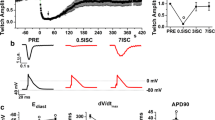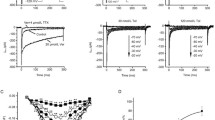Abstract
The aim of this work was to investigate the role of the inward rectifying (K1) and the sarcolemmal ATP-sensitive K+ (K-ATP) channels in the electrical response to regional ischemia and the subsequent development of ventricular tachyarrhythmias on reflow (RA). Surface electrograms (ECG) and the transmembrane potential from subepicardial left ventricular cells were recorded in spontaneously beating rat hearts perfused with buffer alone (controls) or exposed to 100 μM BaCl2 or 100 μM 5-hydroxydecanoate (5-HD) to block either K1 or K-ATP channels respectively. After 20 min of equilibration and 10 min of control recordings, the left anterior descending coronary artery was occluded for 10 min. This was followed by reperfusion. The effects of regional ischemia as well as those of reperfusion (10 min) were recorded throughout. In the three groups, ischemia induced a modest decrease in heart rate and a sharp reduction in resting potential within 3 min. The latter as well as the accompanying depression of propagated electrical activity were enhanced by Ba2+. A partial recovery of the resting potential was observed in all groups during the last 2 min of coronary occlusion. Concomitantly, a slight reduction in the action potential duration was found in the control hearts. This effect was blocked by 5-HD. Under Barium the action potential duration increased by a factor of 3 and its ischemic variations were minimized. Severe sustained ventricular tachyarrhythmias developed on reflow in the controls and in the 5-HD exposed hearts. Barium limited the duration of arrhythmic episodes to a few seconds. Our data indicate that the initial electrical effects of ischemia are unrelated to activation of ATP sensitive K+ channels and that gK1 dominates the K+ membrane conductance at this stage. Furthermore, they show that action potential lengthening limits the duration of arrhythmic episodes triggered by reperfusion. This suggests that electrical heterogeneity plays an important role in the perpetuation of reperfusion arrhythmias.
Similar content being viewed by others
References
Bril A: Cellular mechanisms of cardiac arrhythmias in the ischemic and reperfused heart. In: M. Karmazyn (ed). Myocardial Ischemia: Mechanism, Reperfusion, Protection. Birkhäuser Verlag, Basel, Switzerland, 1996, pp 135-153
Kopacz M, Kawatowska-Prokopczuk E, Beresewicz A: Reperfusion arrhythmias and purine wash-out in isolated rat and rabbit heart. Effect of allopurinol, dimethylthiourea and calcium reduction. J Mol Cell Cardiol 25: 859-874, 1993
Pierce GN, Czubryt MP: The contribution of ionic imbalance to ischemia/reperfusion-induced injury. J Mol Cell Cardiol 27: 53-63, 1995
Ruiz Petrich E, Ponce Zumino A, Moffat MP, Rioux Y, Schanne OF: Modulation of the electrophysiological effects of ischemia reperfusion by methylisobutyl amiloride. J Mol Cell Cardiol 28: 1129-1141, 1996
Ponce Zumino AZ, Risler NR, Schanne OF, Ruiz Petrich E, Carrión A: Magnesium: Effects on reperfusion arrhythmias and membrane potential in isolated rat hearts. Mol Cell Biochem 171: 85-93, 1997
Ver Donck L, Borgers M, Verdonck F: Inhibition of sodium and calcium overload pathology in the myocardium: A new cytoprotective principle. Cardiovasc Res 27: 349-357, 1993
Baiardi G, Carrión A, Ruiz Petrich E, Ponce Zumino A: 4-Aminopyridine: Effects on electrical activity during ischemia and reperfusion in perfused rat hearts. Mol Cell Biochem 233: 85-90, 2002
Rees SA, Curtis MJ: Further investigations into the mechanism of antifibrillatory action of the specific IK1 blocker, RP58866, assessed using the rat dual coronary perfusion model. J Mol Cell Cardiol 27: 2595-2606, 1995
Coghlan MJ, Carroll WA, Gopalakrishnan M: Recent developments in the biology and medicinal chemistry of potassium channel modulators: Update from a decade of progress. J Med Chem 44: 1627-1653, 2001
Notsu T, Tanaka I, Takano M, Noma A: Blockade of the ATP-sensitive K+ channel by 5-hydroxydecanoate in guinea pig ventricular myocytes. J Pharmacol Exp Ther 260: 702-708, 1992
Schultz JEJ, Qian YZ, Gross GJ, Kurkreja RC: The ischemia-selective KATP channel antagonist, 5-hydroxydecanoate, blocks ischemic preconditioning in the rat heart. J Mol Cell Cardiol 29: 1055-1060, 1997
Walker MJA, Curtis MJ, Hearse DJ, Campbell RWF, Janse MJ, Yellon DM, Cobbe SM, Coker SJ, Harness JB, Harron DWG, Higgins AJ, Julian DG, Lab MJ, Manning AS, Northover BJ, Parratt JR, Riemersma RA, Riva E, Russell DC, Sheridan DJ, Winslow E, Woodward B: The Lambeth conventions: Guidelines for the study of arrhythmias in ischaemia, infarction, and reperfusion. Cardiovasc Res 22: 447-455, 1988
Ponce Zumino A, Baiardi G, Schanne OF, Ruiz Petrich E: Differential electrophysiologic effects of global and regional ischemia and reperfusion in perfused rat hearts. Effects of Mg2+ concentration. Mol Cell Biochem 186: 79-86, 1998
Ruiz Petrich E, Schanne OF, Ponce Zumino A: Electrophysiological responses to ischemia and reperfusion. In: M. Karmazyn (ed). Myocardial Ischemia: Mechanisms, Reperfusion, Protection. Birkhäuser Verlag, Basel, Switzerland, 1996, pp 115-133
Wilde AAM, Aksnes G: Myocardial potassium loss and cell depolarization in ischaemia and hypoxia. Cardiovasc Res 29: 1-15, 1995
Yan GX, Yamada KA, Kléber AG, McHowat J, Corr PB: Dissociation between cellular K+ loss, reduction in repolarization time, and tissue ATP levels during myocardial hypoxia and ischemia. Circ Res 72: 560-570, 1993
Henry P, Popescu A, Pucéat M, Hinescu ME, Escande D: Acute simulated ischaemia produces both inhibition and activation of K+ currents in isolated ventricular myocytes. Cardiovasc Res 32: 930-939, 1996
Watanabe I, Kanda A, Engle CL, Gettes LS: Comparison of the effects of regional ischemia and hyperkalemia on the membrane action potentials of the in situ pig heart. J Cardiovasc Electrophysiol 8: 1229-1236, 1997
Mitani A, Shattock MJ: Role of Na-activated K channel, Na-K-Cl cotransport, and Na-K pump in [K]o changes during ischemia in rat heart. Am J Physiol 263: H333-H340, 1992
Vanheel B, de Hemptinne A: Influence of K-ATP channel modulation on net potassium efflux from ischaemic mammalian cardiac tissue. Cardiovasc Res 26: 1030-1039, 1992
Ruiz Petrich E, Cai S, Rioux Y, Schanne OF, Ponce Zumino A: An inward rectifying K+ current is involved in the electrophysiological response to hypoxia. Exp Clin Cardiol 4: 159-167, 1999
Wilde AAM, Escande D, Schumacker CA, Thuringer D, Mestre M, Fiolet JWT, Janse MJ: Potassium accumulation in the globally ischemic mammalian heart: A role for the ATP-sensitive K+ channel. Circ Res 67: 835-843, 1990
Karwatowska-Krynska E, Beresewicz A: Effect of locally released catecholamines on lipolysis and injury of the hypoxic isolated rabbit heart. J Mol Cell Cardiol 15: 523-536, 1983
Rosen MR: Delayed afterdepolarizations induced by digitalis. In: M.R. Rosen, M. J. Janse, A.L. Wit (eds). Cardiac Electrophysiology: A Textbook. Futura Publishing Company, Inc., Mount Kisco, NY, 1990 pp 273-281
Coetze WA, Opie LH: Effects of components of ischemia and metabolic inhibition on delayed afterdepolarizations in guinea pig papillary muscle. Circ Res 61: 157-165, 1987
El-Sherif N, Gough WB, Zeiler RH, Mehra R. Triggered ventricular rhythms in 1-day-old myocardial infarction in the dog. Circ Res 52: 566-579, 1983
Anderson SE, Murphy E, Steenbergen C, London RE, Cala PM: Na-H exchange in myocardium: effects of hypoxia and acidification on Na and Ca. Am J Physiol 259: C940-C948, 1990
Murphy E, Perlman M, London RE, Steenbergen C: Amiloride delays the ischemia-induced rise in cytosolic free calcium. Circ Res 68: 1250-1258, 1991
Shattock MJ, Bers DM: Rat vs. rabbit ventricle: Ca flux and intracellular Na assessed by ion-selective microelectrodes. Am J Physiol 256: C813-C822, 1989
Coronel R: Heterogeneity in extracellular potassium concentration during early myocardial ischaemia and reperfusion: Implications for arrhythmogenesis. Cardiovasc Res 28: 770-777, 1994
McPherson CD, Pierce GN, Cole WC: Ischemic cardioprotection by ATP-sensitive K+ channels involves high-energy phosphate preservation. Am J Physiol 265: H1809-H1818, 1993
Liu Y, Sato T, O'Rourke B, Marban E: Mitochondrial ATP-dependent potassium channels: novel effectors of cardioprotection? Circulation 97: 2463-2469, 1998
Garlid KD, Paucek P, Yarov-Yarovoy V, Murray HN, Darbenzio RB, D'Alonzo AJ, Lodge NJ, Smith MA, Grover GJ: Cardioprotective effect of diazoxide and its interaction with mitochondrial ATP-sensitive K+ channels. Circ Res 81: 1072-1082, 1997
Grover GJ, D'Alonzo AJ, Garlid KD, Bajgar R, Lodge NJ, Sleph PG, Darbenzio RB, Hess TA, Smith MA, Paucek P, Atwal KS: Pharmacologic characterization of BMS-191095, a mitochondrial KATP opener with no peripheral vasodilator or cardiac action potential shortening activity. J Pharmacol Exp Ther 297: 1184-1192, 2001
Author information
Authors and Affiliations
Rights and permissions
About this article
Cite this article
Baiardi, G., Ponce Zumino, A. & Ruiz Petrich, E. Effects of barium and 5-hydroxydecanoate on the electrophysiologic response to acute regional ischemia and reperfusion in rat hearts. Mol Cell Biochem 254, 185–191 (2003). https://doi.org/10.1023/A:1027384215339
Issue Date:
DOI: https://doi.org/10.1023/A:1027384215339




